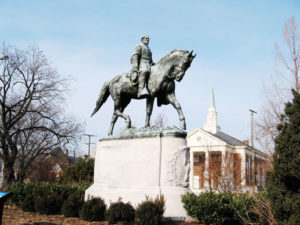We cannot delete history or hide it. I’m not sure that whitewashing it helps either, but over the past few days we Americans, along with the rest of the world, have witnessed a powerful undertow of ignorance and hatred unleashed almost as though the only part of our political correctness that matters has been surrendered to the adrenalin rush of mob rage.
Charlottesville, Virginia is certainly not the only place where contempt and laser-like hostility have found a home. They have also found nesting places in Chicago, Baltimore, and other cities where people want or need to find stereotypes and scapegoats for their own social and economic misery.
The fairly recent obsession of eradicating statues of the past I can begin to understand in terms of the oppression that some of those sculptures symbolize for people whose ancestors suffered the ravaging indignities of slavery. However, I have seen statues all over the world that have impressed me by their beauty and perfection, often through their nude forms or romantic historical significance, forms that appalled Victorians and many American fundamentalists of the 19th and 20th Centuries. The difference of that art may be that they were mostly in museums and didn’t represent social norms for everyone. Assuming what a statue symbolizes (beyond its mere physical presence) can become a guessing game with ugly consequences.
To a white man from the deep south, a statue of Robert E. Lee may represent a romantic, Margaret Mitchell view of a period long gone, of beautiful plantations, White columned Palladio homes, the scent of sweet magnolias, moss-draped cypress trees under which genteel folk drank mint julips on warm afternoons in the shade. Some want to see heroism, even though they lost the Civil War, but a black man may see in the same statue only subjugation and injustice from a time when human beings were bought and sold as property. This dichotomy is an issue partly because such statues are in prominent places in major cities that are no longer controlled merely by white citizens. The bitterness for those white folks has not yet disappeared, but the memory of repression for blacks lingers like the taste, not of a mint julip, but of blood. Two people looking at the same sculpture will likely have different and possibly opposing feelings about it. One city in the south actually had a Robert E. Lee insignia and image as the police department logo on the police cars. I wonder how a black man pulled over and arrested might feel about that rather thoughtless choice. There has to be some kind of balance or middle ground.
Such statues (of heroes whose side lost the Civil War in 1865) are still symbols of what many whites see as a lost world that they have romanticized beyond recognition. They can’t let go of that mythical world. The statues would have appropriate homes in museums, because we should not forget history but rather see it through more enlightened eyes. That is, we need to see history for what it was, not try to sweep it under the rug. The idea of studying history is in great part an attempt to learn from our mistakes, isn’t it? If statues of Adolf Hitler and Hermann Goering were erected in any European or American cities, I would expect an immediate and violent backlash against the indignity of such brazen stupidity. However, our scenario is not quite the same.
A statue of Robert E. Lee (in most respects an educated, civilized gentleman) is a figure of history whom the public can judge in various ways, according to point of view (I think that’s what we still do in America). He was not a monster but rather a man whose view in his own time was skewed by a past to which many greedy and unenlightened people still clung tightly in a fading, outwardly lovely environment based upon incredible hypocrisy and domination (encouraged even by many churches of that time) which, though thousands of years old, was on the verge of its inevitable collapse. People are good or bad, not because of their skin color, a lesson with which many are still struggling through threats and violence, which they naively believe will actually solve the problems.
Statues can show us some of the supposed gentility we have lost and what coercion and violence we should have left behind. In that way, such sculptures can remind us of how far we’ve come, or at least how far we SHOULD have come in advancing civilization for everyone. JB






